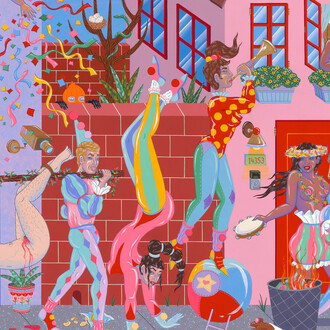Into the light presents the works of Fabián Burgos and Moisés Ortiz in a complementary way: they both work with geometric abstraction, playing with form and matter and using light as one of the key instruments of their construction.
Different but related, their art makes our sight, our minds, permeable to their conceptual and material thinking, to let that light shine on us.
Fabián Burgos’s works are precise and illuminating, they bring light to the spectator’s eye through plastic optic effects. For example, his series “Velocidad” (Speed) shows material conditions turned into energy: the passageway between colors of oil emulates a speeding light going through the canvas, as the chromatic transitions are subtle and almost indiscernible, a true victory of manual skill and technique. The result is a strong metaphor of contemporary life moving at the speed of light, a non-stop motion that goes only forward.
Something similar can be found in “Double cone” (2020), achieved by creating a perspective where two triangular shapes move transversally through a plane, as though invading another universe, another visual space. The impulse of the paint is what guides Burgos through the composition, and the shapes and colors are therefore the result of a subordinate relation. Lines, dots, angles, spirals, all metaphors for the way we perceive reality, geometry, our relationship to the world. The artist works with them, through them, changing tones or contrasts. In “Orange Optic” (2021), for instance, a sense of movement is the resulting effect of the juxtaposition of curved color lines. The acrylic feels like dense waves moving outwards from the canvas to our eyes.
In “Untitled” (2010), the dots form maps, blueprints, and at the same time divide colors into what could be a flag. The organization of the dots is specific yet random, it’s precise but brings about questions about what’s real and what’s imagined, between matter and empty space.
Moisés Ortiz experiments with media to express thought, reason, and a perspective on life. His paintings follow the tradition of geometric abstraction in a different way than Burgos: he works within the frames of cubist multiplicity. Yet, Ortiz innovates by stretching the limits of possibility, incorporating street art methods, concepts, and materials. In works like “Natura Morte” or “Symbiosis” (2022) the plastic values of Kandinsky expand towards strongly saturated backgrounds. The mixture of acrylic and spray paint results in ambiguity: the light source of the artworks becomes multiple, difficult to place.
Ortiz pioneers in combining the traditional cubist procedure with that of graffiti art, proving to be both creative and expressive, and providing us with a gateway to his thoughts about the dynamics of life and death, about nature and social bonds. The light in Ortiz’s works is a strong metaphor for his point of view. He has something to say. His impulse lies within; experimenting with media is a way to express his concerns. In “Ronin” (2022), the diptych contradicts the title, a Samurai with no Lord, Master, or any family ties. The tension between image and word gives the piece its form: a shape that is confronted with another version of itself, made through a mixed technique, and illuminated from all sides by its aluminum support. The question about human relations becomes a material and aesthetic concern.
Burgos and Ortiz conceive light, color, and shape in a way that brings us to their world and brings the world closer to us. Their artistry is alchemic, generating light, movement, and change. Like beautiful music, their geometry resonates on both the canvas and our lives. The impervious limits of what we know become porous to new sensations thanks to these artists’ luminous creations.
(Curatorial text by Jonathan Feldman)














